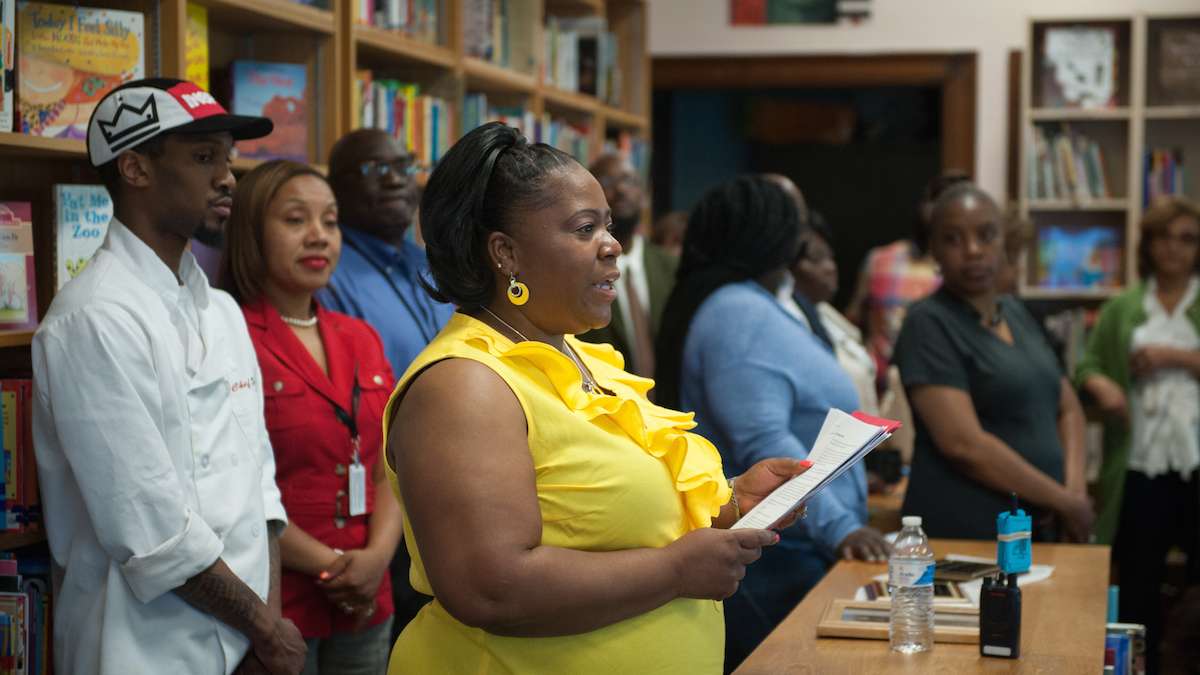These 5 Philly schools made big test score improvements. What’s their secret?

Students at Emlen Elementary School showed signifcant improvement in PSSA scores. (Tracie Van Auken for NewsWorks
When Tammy Thomas, principal at Eleanor Emlen School, first saw her school’s standardized test scores for 2016, she didn’t feel excited. She felt relieved.
“My reaction was: ‘Thank goodness we didn’t go down in anything,'” said Thomas, who heads the K-5 school in East Mount Airy.
That may sound fatalistic, but it’s understandable.
In 2015, test scores plummeted around the state as Pennsylvania introduced new versions of the math and English PSSAs — standardized exams given to third-through-eighth graders. These updated assessments were aligned to the Common Core standards and designed to be much tougher than their predecessor exams.
Many wondered whether scores would start to rebound in 2016 as everyone adjusted to the new tests.
For Philadelphia schools, the short answer was no. Philadelphia students did about as well — or about as poorly — in 2016 as they did in 2015. Math scores went up one percentage point, from 17 percent on grade level to 18 percent. English scores were totally flat, with 32 percent of Philly kids testing proficient or better.
That, however, doesn’t mean there weren’t outliers. In fact dozens of Philadelphia schools showed significant improvement on either the math PSSA, the English PSSA, or both. In all, we counted 32 traditional district schools where the percent of students who tested at grade level or higher on the math or English PSSAs improved by five percentage points or more.
These were schools that improved significantly more than the state as a whole — where math scores increased just 2.5 percentage points.
The schools that made the leap in math are shown in the chart below.
| SCHOOL | PERCENTAGE POINT IMPROVEMENT | PERCENT ECONOMICALLY DISADVANTAGED |
| Hill-Freedman | 24.6% | 63.63% |
| William Meredith | 18.8% | 24.46% |
| Frances Willard | 15.0% | 100% |
| Rhawnhurst | 13.7% | 75.99% |
| Girard Academic Music Program | 11.0% | 42.66% |
| Isaac Sheppard | 10.5% | 100% |
| Samuel Powel | 9.1% | 67.83% |
| Penn Alexander | 8.9% | 28.37% |
| Eleanor Emlen | 7.6% | 100% |
| Julia Howe | 7.5% | 100% |
| Robert Morris | 7.5% | 100% |
| Martha Washington | 6.9% | 100% |
| Bache-Martin | 6.7% | 100% |
| Andrew Jackson | 6.4% | 100% |
| A.S. Jenks | 6.4% | 67.54% |
| Chester Arthur | 5.7% | 100% |
| James Ludlow | 5.7% | 100% |
| Albert Greenfield | 5.7% | 28.17% |
| John Hancock | 5.5% | 47.95% |
| Henry Lawton | 5.3% | 100% |
| Alexander Adaire | 5.2% | 100% |
| William Cramp | 5.1% | 100% |
| Cook-Wissahickon | 5.0% | 66.58% |
| Thomas Finletter | 5.0% | 81.87% |
| DISTRICT AVERAGE | 1.0% | 86% |
The schools that improved dramatically on the English Language Arts PSSA are shown in the chart below.
| SCHOOL | PERCENTAGE POINT IMPROVEMENT | PERCENT ECONOMICALLY DISADVANTAGE |
| AMY Northwest | 10.8% | 65.82% |
| Eleanor Emlen | 9.7% | 100% |
| Albert Greenfield | 9.4% | 28.17% |
| Frances Willard | 8.8% | 100% |
| Eliza Kirkbride | 8.3% | 100% |
| Olney Elementary | 7.0% | 100% |
| Robert Morris | 7.0% | 100% |
| Hill-Freedman | 6.7% | 63.63% |
| Isaac Sheppard | 6.3% | 100% |
| James Ludlow | 6.0% | 100% |
| Spring Garden | 5.5% | 100% |
| William Rowen | 5.4% | 100% |
| John Hartranft | 5.3% | 100% |
| William Meredith | 5.3% | 24.46% |
| Vare-Washington | 5.3% | 100% |
| Watson Comly | 5.1% | 49.6% |
| DISTRICT AVERAGE | 0.0% | 86% |
Eleanor Emlen belonged to an even more distinguished group. Tammy Thomas’ school improved by five percentage points or more on both the math PSSA and the English PSSA. A NewsWorks/WHYY analysis found just eight schools that could claim such a big jump on both tests.
Here are those schools.
| SCHOOL | MATH IMPROVEMENT | ENGLISH IMPROVEMENT |
| Hill-Freedman | 24.6% | 6.7% |
| William Meredith | 18.8% | 5.3% |
| Frances Willard | 15.0% | 8.8% |
| Isaac Sheppard | 10.5% | 6.3% |
| Eleanor Emlen | 7.6% | 9.7% |
| Robert Morris | 7.5% | 7.0% |
| James Ludlow | 5.7% | 6.0% |
| Albert Greenfield | 5.7% | 9.4% |
The field narrows even further when you isolate schools who improved significantly on both tests and serve a student population that is at least as economically disadvantaged than the School District of Philadelphia as a whole. Just five schools can make that claim in 2016
Again, Emlen made the cut. After initially fearing the worst, Thomas is starting to smile wide.
“I really started to look and said, ‘Wow, we made a significant gain here,'” she said. “Again we’re nowhere where we want to be, but we celebrate small successes.”
In that spirit, NewsWorks/WHYY reached out to the principals of each of the five overachieving district schools to hear their success stories.
Isaac Sheppard: Data, data, data!
Grades: K-4Neighborhood: FairhillPercent economically disadvantaged: 100%Math improvement: 10.5% (5.3% to 15.8%)English improvement: 6.3% (20% to 26.3%)
At Sheppard School it’s all about the numbers.
“We’re gathering data daily,” said principal Marisol Rivera Rodriguez.
That means looking at interim assessments and benchmark assessments to get a real-time handle on whether students understand the material. Last school year Sheppard started using four-week cycles to organize, interpret, and act on the data they were collecting.
Teachers would gather in teams based on different teaching topics. In the first week of the cycle they would analyze test data and draw up a plan to address deficiencies. Weeks two and three would involve putting that plan into place. By week four the plan would, ideally, be running smoothly and the teachers would be gearing up for another get-together.
“[The teachers] worked extremely hard,” said Rodriguez. “All of this is really driven by the teachers.”
Despite the big gains, Sheppard remains below the district average in Math and English (which is 18 percent proficient and 32 percent proficient, respectively).
“I don’t know if we can ever say we’re satisfied,” Rodriguez said. “We’re made some progress, but we have a lot more to go.”
Eleanor Emlen: It’s all about family
Grades: K-5Neighborhood: East Mount AiryPercent economically disadvantaged: 100%Math improvement: 7.6% (8.2% to 15.8%)English improvement: 9.7% (27.2% to 36.9%)
Asked about her school’s improvement, Principal Tammy Thomas points first to the parents.
The school made an extra effort to bring parents in the building and talk to them about what their children were expected to know.
“One of the things we really wanted to impress upon our parents is that they are an important part of their child’s learning,” said Thomas. “They need to know where their child stands academically.”
 Emlen Principal Tammy Thomas says increased parent involvement has played an important role in the school’s success. (Tracie Van Auken for NewsWorks, file)
Emlen Principal Tammy Thomas says increased parent involvement has played an important role in the school’s success. (Tracie Van Auken for NewsWorks, file)
Every month Emlen would hold workshops where teachers would walk parents through the types of problems one might find on the new PSSAs. Emlen also introduced a new twist on afterschool homework. Rather than simply have a parent drop his or her kid off for some added tutoring, Emlen required parents to sit and stay a while.
“The caveat is the parents have to come with them,” said Thomas. “They sit with the teachers … and they go through maybe the lesson of the day.”
Thomas thinks this strategy has been particularly useful because the types of higher-order thinking emphasized on the new PSSA and other Common Core assessments might be unfamiliar to those from an older generation who learned using different methods. And when parents aren’t prepared to help, kids can often fall behind.
Emlen also take sa startlingly direct approach when it comes to improving test scores. At the beginning of the year, teachers sit down with each of their students to go over last year’s results. Each child is expected to create a personal test score goal. The student and teacher then meet quarterly to go over how the student is progressing toward that target, and each student has their own “data folder.”
“We really hold our kids responsible for knowing and tracking their own data,” said Thomas. “We found it was important to sit our kids down with our teachers and meet with them one on one so they could track their own progress.”
Frances Willard: A steady ship
Grades: K-4Neighborhood: KensingtonPercent economically disadvantaged: 100%Math improvement: 15.0% (20.6% to 35.6%)English improvement: 8.8% (28.5% to 37.3%)
The 2016-17 school year will be principal Ron Reilly’s ninth at Frances Willard School — a notable accomplishment, given the high administrative turnover in large, urban school districts. And many of Willard’s teachers, Reilly said, have been there far longer than he.
“I really think that’s a big deal, a big part of it, when you have that kind of stability,” he said.
The staff at Willard may be seasoned, but the school building itself is new. In 2010, the district replaced the crumbling structure that used to house Willard with a $30 million facility. The building, said Reilly, has become “like a beacon in the neighborhood.” Plus, it’s helped create the kind of work environment that keeps teachers returning year after year.
There haven’t been any big changes at Willard, Reilly said. Staff do target struggling students and place them into smaller groups where they can get the help they need. Willard also holds Saturday school in the fall to help get students up to speed.
But all that, Reilly believes, extends from having an experienced and capable staff.
“I think there’s something that needs to be said for consistency and routine,” he said.
Robert Morris: Climate first
Grades: K-8Neighborhood: BrewerytownPercent economically disadvantaged: 100%Math improvement: 7.5% (6.1% to 13.6%)English improvement: 7.0% (13.4% to 20.4%)
If Frances Willard has been a model of consistency, the story at Robert Morris has been all about change.
Last school year was Morris’ first under the guidance of principal Carolyn Williams. Her priority, she said, was creating a safer, more nurturing school climate.
“Children can’t learn unless there’s an environment that’s conducive to learning,” she said.
To that end Williams implemented a “positive behavior intervention system.” That may sound fancy, but it’s a pretty simple concept. Williams wanted to incentivize good behavior rather than just cracking down on ne’er-do-wells.
To wit: Morris has something called the “95 percent club,” which celebrates students who’ve attended school at least 95 percent of the time. Every month, students in the club get a certificate, an assembly in their honor, and a treat. There’s also a weekly trophy for the individual classroom with the highest attendance rate. At the end of the month the classroom with the best attendance tally gets that most cherished of elementary school distinctions — a pizza party.
Williams still kept a close eye on academics. Like other schools on this list, the team at Morris tracked student progress closely by administering a regular diet of exams and using the results to guide instruction.
But all that, Williams said, could only work if the school functioned well. When she first arrived she wanted to convince everyone — students, parents, and staff — that a better, more welcoming school was possible.
“It’s a new beginning for our school,” said Williams. “So that’s what we focused on.”
James Ludlow: Extending for excellence
Grades: K-8Neighborhood: Olde KensingtonPercent economically disadvantaged: 100%Math improvement: 5.7% (10.8% to 16.5%)English improvement: 6.0% (20.2% to 26.2%)
One cannot discuss test scores without discussing test prep.
Opinions on the topic vary, but all acknowledge this: Test prep happens.
Carol Williams, principal at James Ludlow School, has been in the School District of Philadelphia for over three decades. She’s seen test prep before. She knows it’s usefulness. But she also knows overkill when she sees it.
To avoid burning students out, Ludlow offers one-hour after-school prep sessions, but only from January to March. It gives students a chance to brush up on skills without frying their brains. Williams also uses extra federal money afforded to low-income schools like hers to pay her regular teachers for the time they spend at the after-school sessions. That means students who stay the extra hour are learning from the same instructors they learn from during the standard school day.
“They know the strengths and weaknesses of the students who are participating,” Williams said.
The Ludlow staff has also focused more on small-group instruction. Using information gathered from mid-year tests, teachers try to identify which students need help in a given subject area and then deliver targeted lesson plans to those sectioned-off groups.
All this is predicated on gathering data and storing it in a computerized tracking system. To a person, each of the five principals interviewed for this story said the ability to test students periodically throughout the year and harness the statistical feedback played a key role in improving test scores.
Having those hard numbers, said Williams, “gives us another set of eyes to help to give us the support that we need and to answer any questions that we have.”
WHYY is your source for fact-based, in-depth journalism and information. As a nonprofit organization, we rely on financial support from readers like you. Please give today.





